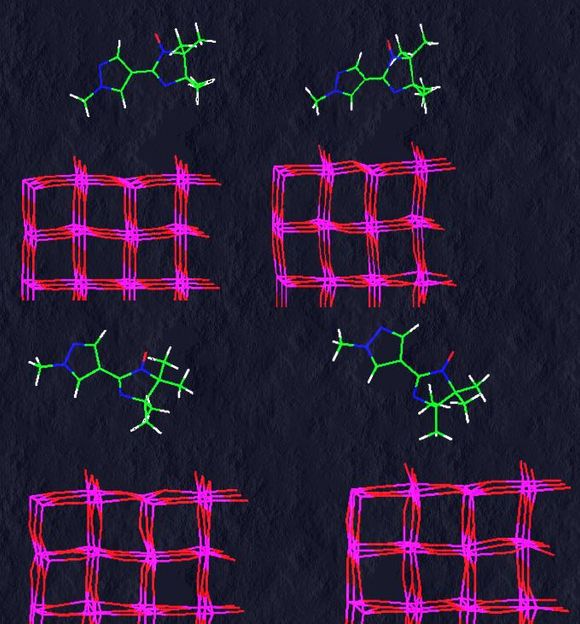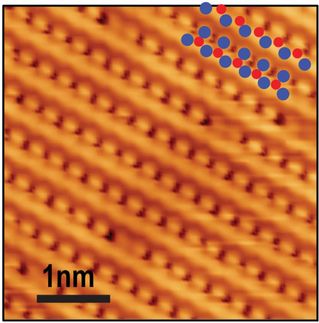Defects at the spinterface disrupt transmission
Researchers put metal-oxides and organic magnets together; applications for electronics in sight
Advertisement
Magnets made of organic materials have a number of advantages over the classic metal or alloy magnets. They are chemically more flexible, cheaper to make, and can be better adapted to various purposes and varying designs. In practice, researchers want to apply both types of magnets in electronics – in spintronic elements, which transport information not by electrical load but via the spin of the component molecules. This intrinsic angular momentum is a typical characteristic of particles, such as electrons. Reza Kakavandi, Professor Thomas Chassé and Dr. Benedetta Casu of the Institute of Physical Chemistry at the University of Tübingen have investigated just such a magnetic interface between the titanium oxide crystals in rutile form and a purely organic magnet. They found that the transition area where the materials met was highly sensitive to minimal defects in the surfaces.

An organic radical approaches a lattice of rutile crystals (red) – here with an ideal surface free of defects
Benedetta Casu und Arrigo Calzolari
Purely organic radicals are composed of light elements such as carbon, nitrogen and oxygen, and usually have one unpaired electron, which creates permanent magnetic momentum. “They are interesting in a whole lot of applications;” says Benedetta Casu, “They can be used particularly in storage elements, batteries, sensors and for biomedical applications. They could also be used in the construction of a quantum computer.” The Tübingen researchers investigated the interface between a single rutile crystal and an organic radical using a very high resolution x-ray spectroscopy procedure combined with theoretical calculations by Dr. Arrigo Calzolari of the Istituto Nanoscienze in Modena, Italy. The researchers call this link between conventional and organic magnets the “spinterface” because it combines the ideas of “spin” and “interface”.
“In this experiment, organic radicals are held in place physically, and the magnetic momentum was kept between the different materials,” says Benedetta Casu. She says it worked well. But, she says, the situation changed completely when there was a tiny defect on the relevant surface of the rutile – i.e., if the crystal surfaces were not ideally ordered. “In that case, the organic radical bonded chemically with the reactive point of the defect, wiping out the magnetic momentum,” Casu explains.
This approach with the combination of x-ray spectroscopy and theoretical calculations proved to be very useful in helping the researchers to understand the mechanisms at this complex interface, according to Casu. The researchers needed to describe both the electrical charges involved as well as the spin. For the first time it became clear what important influences arise from surface defects at one of these spinterfaces. “It’s a key result, equally valid in chemistry and in physics as well as for materials sciences,” says Casu.
Original publication
Most read news
Original publication
Reza Kakavandi, Arrigo Calzolari, Yulia B. Borozdina, Prince Ravat, Thomas Chassé, Martin Baumgarten, M. Benedetta Casu; "Unraveling the mark of surface defects on a spinterface: The nitronyl nitroxide/TiO2(110) interface"; Nano Research; 2016
Topics
Organizations
Other news from the department science
These products might interest you

Get the chemical industry in your inbox
By submitting this form you agree that LUMITOS AG will send you the newsletter(s) selected above by email. Your data will not be passed on to third parties. Your data will be stored and processed in accordance with our data protection regulations. LUMITOS may contact you by email for the purpose of advertising or market and opinion surveys. You can revoke your consent at any time without giving reasons to LUMITOS AG, Ernst-Augustin-Str. 2, 12489 Berlin, Germany or by e-mail at revoke@lumitos.com with effect for the future. In addition, each email contains a link to unsubscribe from the corresponding newsletter.
Most read news
More news from our other portals
See the theme worlds for related content
Topic World Battery Technology
The topic world Battery Technology combines relevant knowledge in a unique way. Here you will find everything about suppliers and their products, webinars, white papers, catalogs and brochures.

Topic World Battery Technology
The topic world Battery Technology combines relevant knowledge in a unique way. Here you will find everything about suppliers and their products, webinars, white papers, catalogs and brochures.
Topic World Spectroscopy
Investigation with spectroscopy gives us unique insights into the composition and structure of materials. From UV-Vis spectroscopy to infrared and Raman spectroscopy to fluorescence and atomic absorption spectroscopy, spectroscopy offers us a wide range of analytical techniques to precisely characterize substances. Immerse yourself in the fascinating world of spectroscopy!

Topic World Spectroscopy
Investigation with spectroscopy gives us unique insights into the composition and structure of materials. From UV-Vis spectroscopy to infrared and Raman spectroscopy to fluorescence and atomic absorption spectroscopy, spectroscopy offers us a wide range of analytical techniques to precisely characterize substances. Immerse yourself in the fascinating world of spectroscopy!
Topic world Sensor technology
Sensor technology has revolutionized the chemical industry by providing accurate, timely and reliable data across a wide range of processes. From monitoring critical parameters in production lines to early detection of potential malfunctions or hazards, sensors are the silent sentinels that ensure quality, efficiency and safety.

Topic world Sensor technology
Sensor technology has revolutionized the chemical industry by providing accurate, timely and reliable data across a wide range of processes. From monitoring critical parameters in production lines to early detection of potential malfunctions or hazards, sensors are the silent sentinels that ensure quality, efficiency and safety.






























































